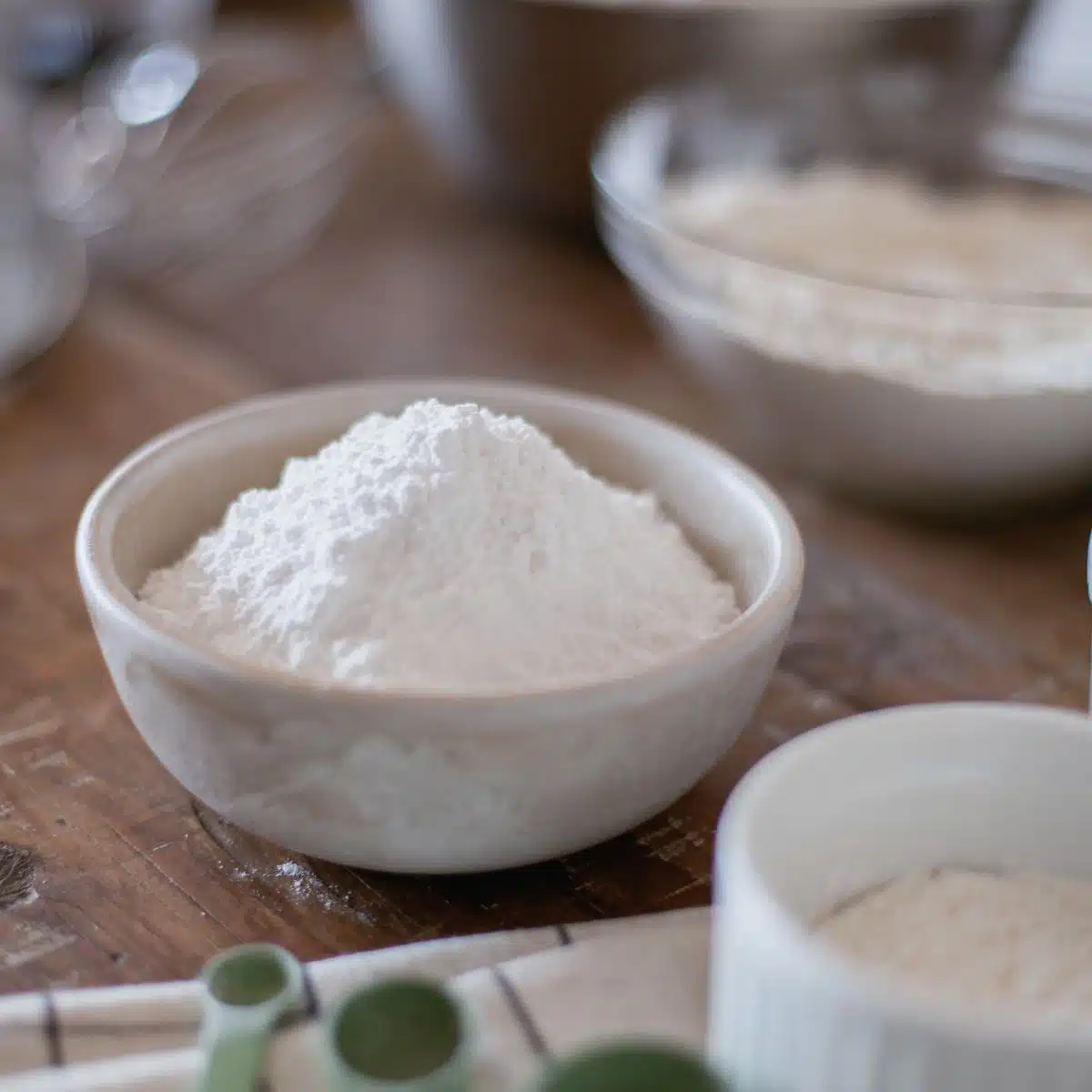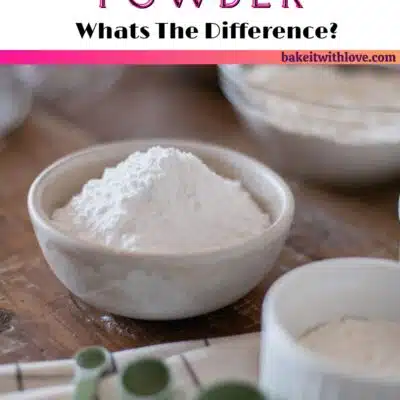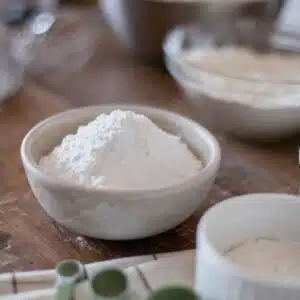Baking soda vs. baking powder: All of the similarities and differences that you need to know about when baking! This is the ultimate guide to understanding everything there is to know about these two common baking ingredients. From how they affect your baked goods to tasty recipes, let's get started!
Comparing Baking Powder & Baking Soda
Whether you are a beginner baker or a professional, you've definitely had to use baking powder or baking soda in your baked goods before. These are such common household ingredients (and they look a lot alike), but do you know what makes them different?

Jump to:
- Comparing Baking Powder & Baking Soda
- What Is Baking Soda
- What Is Baking Powder
- Similarities Between Baking Soda & Baking Powder
- Differences Between Baking Soda & Baking Powder
- When To Use Baking Soda
- When To Use Baking Powder
- Why Do Some Recipes Use Both
- Why Do Some Recipes Not Use Either One
- Can I Substitute Baking Soda & Baking Powder For One Another
- 📖 Recipe Card
- 💬 Comments & Reviews
What Is Baking Soda
Baking soda (or sodium bicarbonate) is a natural, pure, alkaline substance that becomes activated by moisture and acid. Once active, it will produce gas bubbles that will help your baked goods to rise.
If there is no acidic element in your dough or batter, then baking soda cannot work properly. This acidity can be created by using ingredients such as:
- Buttermilk
- Lemon Juice
- Brown Sugar
- Molasses
- Yogurt
- Sour Cream
- Honey
- Fruit or Fruit Juices
- Natural Cocoa Powder
The baking soda will activate as soon as it touches liquid (even before it is baked), which could affect the efficiency if you wait too long to put it in the oven after mixing.
This actually has a term (called 'bench tolerance'), which refers to how long the batter or dough of your baked goods can sit before being baked without losing its leavening.
What Does Baking Soda Do To Baked Goods
We all know that baking is a science, and understanding how baking soda works is also very scientific! When you use baking soda in a recipe, a few things are going to happen.
First of all, baking soda will naturally elevate the pH of your baked goods. As a result, there will be a nice brown color, and the flavor and texture can be changed as well.
In cookies specifically, they will also spread more and have slightly crispy edges. Yum!
How To Test If Baking Soda Is Fresh
If your baking soda has expired or is no longer fresh, it will not work properly, and your baked goods could turn out disappointing. Luckily, there is an easy way to check if it is still fresh!
Simply place ¼ teaspoon of your baking soda into a bowl and add 1 teaspoon of white vinegar over top. If fresh, your baking soda will immediately begin to bubble. However, if it is not bubbling, it is time to toss that container and buy a new one.
What Is Baking Powder
While baking soda is a pure substance, baking powder is actually a combination of a few things: baking soda, an acid (typically cream of tartar), and an anti-caking agent (such as cornstarch).
Yes, baking powder actually includes baking soda! Since it also has an acidic addition, you can use baking powder without having to have an additional acidic ingredient added to your dough or batter.
It will become activated with only moisture and heat. Most of the commercially sold baking powder containers you will find at the store are called "double-acting" since they actually have 2 separate reactions.
The first reaction happens when the baking powder comes into contact with liquid, and the second reaction occurs when baked in the oven. Because of this, batters and doughs using baking powder have a higher bench tolerance than baking soda and can be stored for longer periods of time before baking.
What Does Baking Powder Do To Baked Goods
While baking soda causes the pH to increase, the addition of cream of tartar in baking powder actually causes the pH to decrease and weakens the gluten. If only baking powder is used, you will have a much more delicate and light texture.
How To Test If Baking Powder Is Fresh
Just like baking soda, your baking powder can become ineffective if it is not fresh (even before the expiration date!)
Check it for freshness by placing 1 teaspoon of baking powder into a small bowl. Then, add 1 cup of hot water. If fresh, the baking powder should bubble. If no bubbling occurs, it is time to replace it.
Similarities Between Baking Soda & Baking Powder
While these two items may have different makeups, they do have some strong similarities!
- Leavening Agent: Both baking soda and baking powder are leavening agents. During baking, they release gases in the form of bubbles within the dough or batter, causing the baked goods to set around those air pockets. As a result, the baked goods rise.
- Tenderizing: As the previously mentioned air bubbles expand, the cells within the baked goods stretch and become thinner. Because of this, you can enjoy some extra tender treats.
- Flavor: Using these leavening agents can contribute a salty and slightly sour flavor.
Why It's Important To Use A Leavener
If you are whipping up a batch of your favorite baked goods and decide to leave out your leavening agent (either baking powder, baking soda, or both), here's what will happen.
Your baked goods will turn out extremely dense, as nothing promoted them to rise and expand. They may also taste slightly underbaked, even if you baked them for the proper amount of time.
Differences Between Baking Soda & Baking Powder
While they may both be leavening agents, they definitely are not the same. Here are some differences.
- Strength: Baking soda is actually 4 times stronger than baking powder.
- Ingredients: Baking soda is 100% sodium bicarbonate while baking powder is a combination of ingredients, including baking soda, an acid, and an anti-caking agent.
- Activation: Baking soda needs moisture and acid in order to activate while baking powder needs moisture and heat.
When To Use Baking Soda
Since baking soda needs acid in order to activate, you will commonly see it as the leavening agent in recipes that have another acidic ingredient (such as cocoa powder or buttermilk).
Recipes Using Baking Soda
When To Use Baking Powder
Since baking powder already has an acid in it, it can easily be used in recipes that don't contain any other acidic ingredients (which would be needed for baking soda).
Recipes Using Baking Powder
Why Do Some Recipes Use Both
Essentially, baking soda will neutralize the acid in your acidic ingredients (including the flavor!) If you want to keep the flavor of your acid (such as buttermilk biscuits), you can use both baking soda and baking powder to provide enough lift and rise without losing the well-loved tang.
On the other hand, baking soda alone may not provide enough of a rise. However, if you use too much of it, you can experience a metallic or bitter flavor. Using both baking powder and baking soda can help you achieve the best of both worlds!
Why Do Some Recipes Not Use Either One
Believe it or not, there are actually some baking recipes out there that don't require a chemical leavening agent. Here are some examples of these types of recipes.
- Baked goods involving yeast. Yeast is a natural, organic leavener, which is why many bread recipes do not use baking powder or baking soda (like my brown bread or rustic bread).
- Baked goods that whip a lot of extra air into the dough or batter (or use whipped egg whites), as these already have the added bubbles and air that the leavening agent would typically add.
- Custard-based treats, since the desired texture is meant to be thick and rich (like buttermilk pie or chocolate chess pie).
Can I Substitute Baking Soda & Baking Powder For One Another
Overall, it is best to avoid substituting these ingredients, but you can make it work if you are in a pinch. You can exchange these two ingredients for one another, but not for an even 1:1 swap.
If you need to replace baking soda, you can use 3 times as much baking powder (since it isn't as strong). Alternatively, you can check out my baking soda substitutions.
However, replacing baking powder isn't as straightforward since it is a combination of ingredients. You can substitute 1 teaspoon of baking powder by combining ¼ teaspoon of baking soda + ¼ teaspoon of cornstarch + ½ teaspoon of cream of tartar. Or, check out my baking powder substitutions.
>>>>See all of my recipes here<<<<
Now you know everything there is to know about baking soda and baking powder! What tasty treats are you going to make first?
Do you love a recipe you tried? Please leave a 5-star 🌟rating in the recipe card below and/or a review in the comments section further down the page.
Stay in touch with me through social media @ Pinterest, Facebook, Instagram, or Twitter! Subscribe to the newsletter today (no spam, I promise)! Don't forget to tag me when you try one of my recipes!
📖 Recipe Card
Baking Soda vs Baking Powder: Homemade Baking Powder (+More Information!)
Ingredients
- 1 teaspoon baking soda
- 2 teaspoon cream of tartar
- 1 teaspoon cornstarch
(Note: 2x or 3x only changes the ingredient list)
Instructions
- In a small bowl, whisk together 1 teaspoon baking soda, 2 teaspoon cream of tartar, and 1 teaspoon cornstarch.
- Use as a 1:1 replacement for baking powder or store in an airtight container for later.
Notes
- This homemade baking powder can easily be used in a pinch when you've run out of baking powder. However, keep in mind that this won't be "double-acting" as the store-bought version is.
- Keep your homemade baking powder stored in a sealed container until ready to use. The exact shelf-life will depend on how fresh your baking soda was when you made your homemade baking powder.



Comments
No Comments